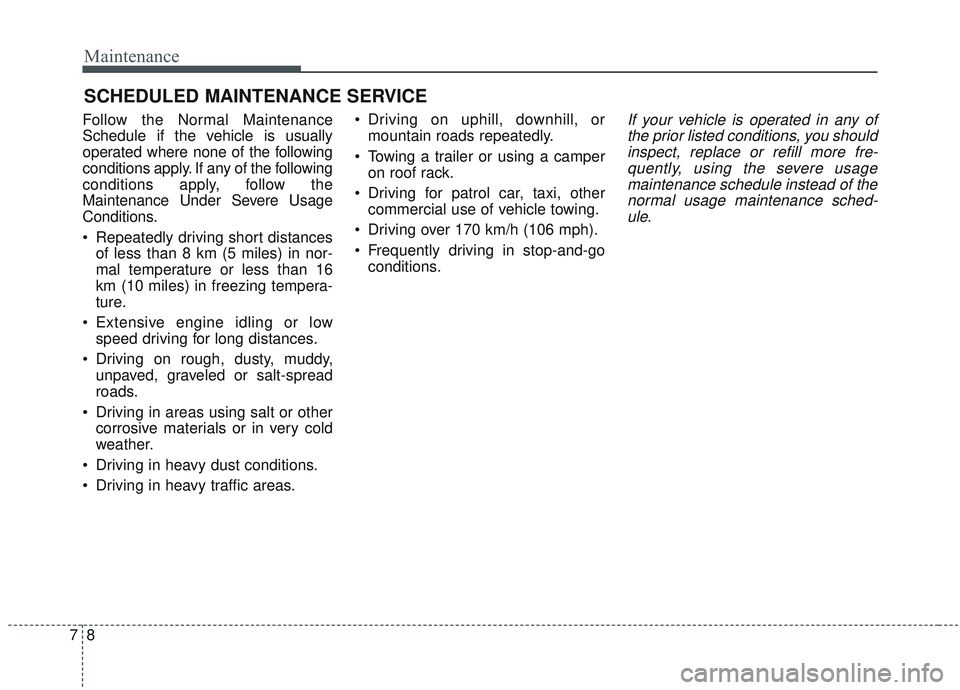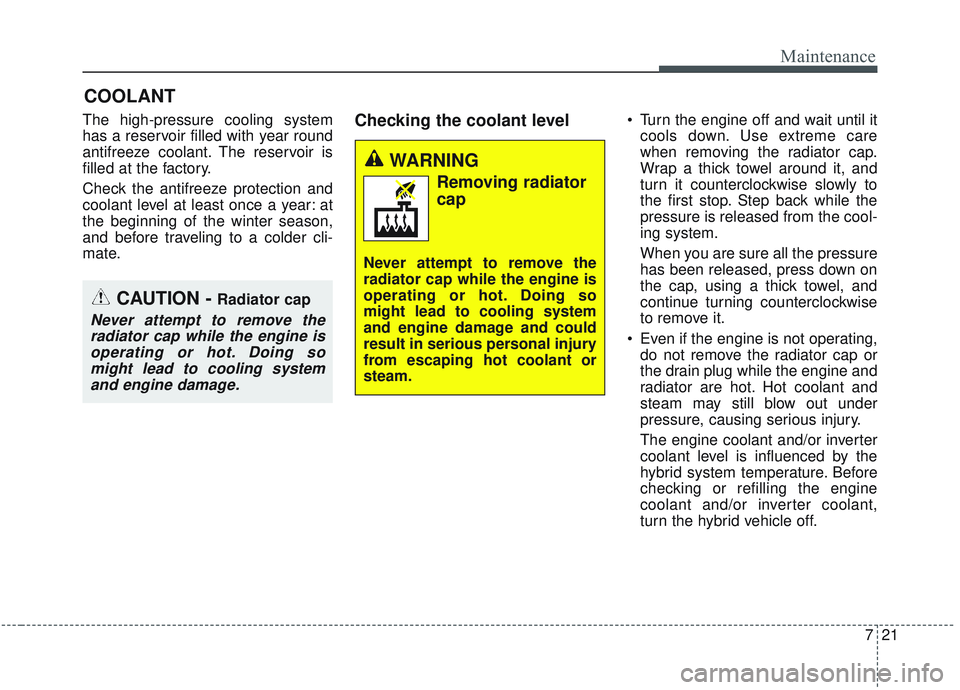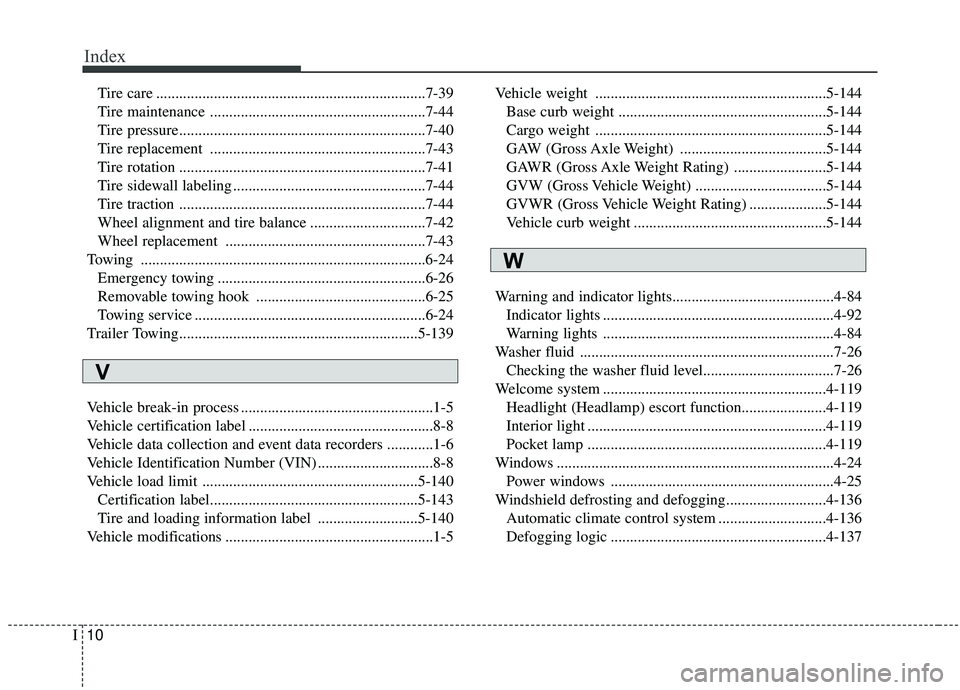tow KIA OPTIMA 2020 Workshop Manual
[x] Cancel search | Manufacturer: KIA, Model Year: 2020, Model line: OPTIMA, Model: KIA OPTIMA 2020Pages: 589, PDF Size: 11.37 MB
Page 474 of 589

Maintenance
87
SCHEDULED MAINTENANCE SERVICE
Follow the Normal Maintenance
Schedule if the vehicle is usually
operated where none of the following
conditions apply. If any of the following
conditions apply, follow the
Maintenance Under Severe Usage
Conditions.
Repeatedly driving short distancesof less than 8 km (5 miles) in nor-
mal temperature or less than 16
km (10 miles) in freezing tempera-
ture.
Extensive engine idling or low speed driving for long distances.
Driving on rough, dusty, muddy, unpaved, graveled or salt-spread
roads.
Driving in areas using salt or other corrosive materials or in very cold
weather.
Driving in heavy dust conditions.
Driving in heavy traffic areas. Driving on uphill, downhill, or
mountain roads repeatedly.
Towing a trailer or using a camper on roof rack.
Driving for patrol car, taxi, other commercial use of vehicle towing.
Driving over 170 km/h (106 mph).
Frequently driving in stop-and-go conditions.If your vehicle is operated in any ofthe prior listed conditions, you shouldinspect, replace or refill more fre-quently, using the severe usagemaintenance schedule instead of thenormal usage maintenance sched-ule.
Page 479 of 589

713
Maintenance
Severe driving conditions
A - Repeatedly driving short distances of less than 8 km (5miles) in normal temperature or less than 16 km (10 miles)
in freezing temperature
B - Extensive engine idling or low speed driving for long dis- tances
C - Driving on rough, dusty, muddy, unpaved, graveled or salt- spread roads
D - Driving in areas using salt or other corrosive materials or in very cold weather E - Driving in heavy dust conditions
F - Driving in heavy traffic areas
G- Driving on uphill, downhill, or mountain roads repeatedly
H - Towing a Trailer, or using a camper, or roof rack
I - Driving as a patrol car, taxi, other commercial use or vehicle
towing
J - Driving over 170 km/h (106 mph)
K - Frequently driving in stop-and-go conditions
MAINTENANCE ITEMMAINTENANCE OPERATIONMAINTENANCE INTERVALSDRIVING
CONDITION
Drive shafts and bootsIEvery 12,000 km (7,500 miles) or 6 monthsC, D, E, F,G, H, I, J
Climate control air filterRMore frequentlyC, E, G
Page 487 of 589

721
Maintenance
COOLANT
The high-pressure cooling system
has a reservoir filled with year round
antifreeze coolant. The reservoir is
filled at the factory.
Check the antifreeze protection and
coolant level at least once a year: at
the beginning of the winter season,
and before traveling to a colder cli-
mate.Checking the coolant level Turn the engine off and wait until itcools down. Use extreme care
when removing the radiator cap.
Wrap a thick towel around it, and
turn it counterclockwise slowly to
the first stop. Step back while the
pressure is released from the cool-
ing system.
When you are sure all the pressure
has been released, press down on
the cap, using a thick towel, and
continue turning counterclockwise
to remove it.
Even if the engine is not operating, do not remove the radiator cap or
the drain plug while the engine and
radiator are hot. Hot coolant and
steam may still blow out under
pressure, causing serious injury.
The engine coolant and/or inverter
coolant level is influenced by the
hybrid system temperature. Before
checking or refilling the engine
coolant and/or inverter coolant,
turn the hybrid vehicle off.
WARNING
Removing radiator
cap
Never attempt to remove the
radiator cap while the engine is
operating or hot. Doing so
might lead to cooling system
and engine damage and could
result in serious personal injury
from escaping hot coolant or
steam.
CAUTION - Radiator cap
Never attempt to remove theradiator cap while the engine isoperating or hot. Doing somight lead to cooling systemand engine damage.
Page 588 of 589

Index
10I
Tire care ......................................................................7-\
39
Tire maintenance ........................................................7-44
Tire pressure................................................................7-40
Tire replacement ........................................................7-43
Tire rotation ................................................................7-41
Tire sidewall labeling ..................................................7-44
Tire traction ................................................................7-44
Wheel alignment and tire balance ..............................7-42
Wheel replacement ....................................................7-43
Towing ........................................................................\
..6-24 Emergency towing ......................................................6-26
Removable towing hook ............................................6-25
Towing service ............................................................6-24
Trailer Towing..............................................................5-139
Vehicle break-in process ..................................................1-5
Vehicle certification label ................................................8-8
Vehicle data collection and event data recorders ............1-6
Vehicle Identification Number (VIN) ..............................8-8
Vehicle load limit ........................................................5-140 Certification label......................................................5-143
Tire and loading information label ..........................5-140
Vehicle modifications ......................................................1-5 Vehicle weight ............................................................5-144
Base curb weight ......................................................5-144
Cargo weight ............................................................5-144
GAW (Gross Axle Weight) ......................................5-144
GAWR (Gross Axle Weight Rating) ........................5-144
GVW (Gross Vehicle Weight) ..................................5-144
GVWR (Gross Vehicle Weight Rating) ....................5-144
Vehicle curb weight ..................................................5-144
Warning and indicator lights..........................................4-84 Indicator lights ............................................................4-92
Warning lights ............................................................4-84
Washer fluid ..................................................................7-26 Checking the washer fluid level..................................7-26
Welcome system ..........................................................4-119 Headlight (Headlamp) escort function......................4-119
Interior light ..............................................................4-119
Pocket lamp ..............................................................4-119
Windows ........................................................................\
4-24 Power windows ..........................................................4-25
Windshield defrosting and defogging..........................4-136 Automatic climate control system ............................4-136
Defogging logic ........................................................4-137
V
W